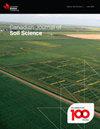Influence of landscape position and climatic seasonality on soil water and gas conductivity properties in agricultural soils
IF 1.5
4区 农林科学
Q4 SOIL SCIENCE
引用次数: 0
Abstract
Agricultural landscape management and climate seasonality can influence soil structure, hydraulic conductivity, and air permeability within the context of soil water and soil gas mobility. To investigate this, in situ and laboratory-based data were collected from three agricultural landscape positions within a watershed in eastern Ontario, Canada during a growing season. Macropore classification, water infiltration tests, and air permeability measurements were conducted in situ and standard soil characterizations were carried out on soil samples. Hydraulic conductivity of the soil matrix, based on grain size data, indicated that the highest values were consistently measured in the B horizon at each landscape setting. Macropores were found to be more abundant within uncultivated drainage ditch bank soils, compared to the adjacent cropped fields. Macropores in the ditch bank soils were exclusively consisted of circular biopores, while both circular and linear macropores were observed in the cultivated field soils. Air permeability, vertical hydraulic conductivity, and horizontal hydraulic conductivity were also greater in the uncultivated soils, relative to the cultivated soils. Field saturated hydraulic conductivity measurements offered evidence of anisotropy, likely due to the vertical nature of the macropore features. Macropore disposition and extent varied over the growing season, especially in the cultivated field soils where tillage and field trafficking are physically disruptive. Seasonality of macropore development will influence temporal changes in advection-based mass exchange of gas and water in the vadose zone. Modeling of mass exchange in agricultural soils should consider time variability in macroporosity to more realistically characterize infiltration and soil gas emissions.景观位置和气候季节对农业土壤水分和气体传导特性的影响
农业景观管理和气候季节性可以在土壤水分和土壤气体流动性的背景下影响土壤结构、水力导电性和空气渗透性。为了调查这一点,在加拿大安大略省东部一个流域内的三个农业景观位置收集了生长季节的现场和实验室数据。在现场进行了大孔分类、水入渗试验和透气性测量,并对土壤样品进行了标准土壤表征。基于粒径数据的土壤基质水力导电性表明,在每个景观设置中,B层的土壤基质导电性值一致最高。与邻近的农田相比,未开垦的排水沟堤岸土壤中大孔隙更为丰富。沟岸土壤的大孔主要由圆形生物孔组成,而农田土壤的大孔既有圆形的,也有线状的。与耕作土壤相比,未耕作土壤的透气性、垂直导水性和水平导水性也更高。现场饱和水力导电性测量提供了各向异性的证据,可能是由于大孔隙特征的垂直性质。大孔分布和范围随生长季节的变化而变化,特别是在耕作和田间运输具有物理破坏性的耕地土壤中。大孔隙发育的季节性将影响气包带中基于平流的气水质量交换的时间变化。农业土壤质量交换模型应考虑大孔隙度的时间变异性,以更真实地表征入渗和土壤气体排放。
本文章由计算机程序翻译,如有差异,请以英文原文为准。
求助全文
约1分钟内获得全文
求助全文
来源期刊

Canadian Journal of Soil Science
农林科学-土壤科学
CiteScore
2.90
自引率
11.80%
发文量
73
审稿时长
6.0 months
期刊介绍:
The Canadian Journal of Soil Science is an international peer-reviewed journal published in cooperation with the Canadian Society of Soil Science. The journal publishes original research on the use, management, structure and development of soils and draws from the disciplines of soil science, agrometeorology, ecology, agricultural engineering, environmental science, hydrology, forestry, geology, geography and climatology. Research is published in a number of topic sections including: agrometeorology; ecology, biological processes and plant interactions; composition and chemical processes; physical processes and interfaces; genesis, landscape processes and relationships; contamination and environmental stewardship; and management for agricultural, forestry and urban uses.
 求助内容:
求助内容: 应助结果提醒方式:
应助结果提醒方式:


